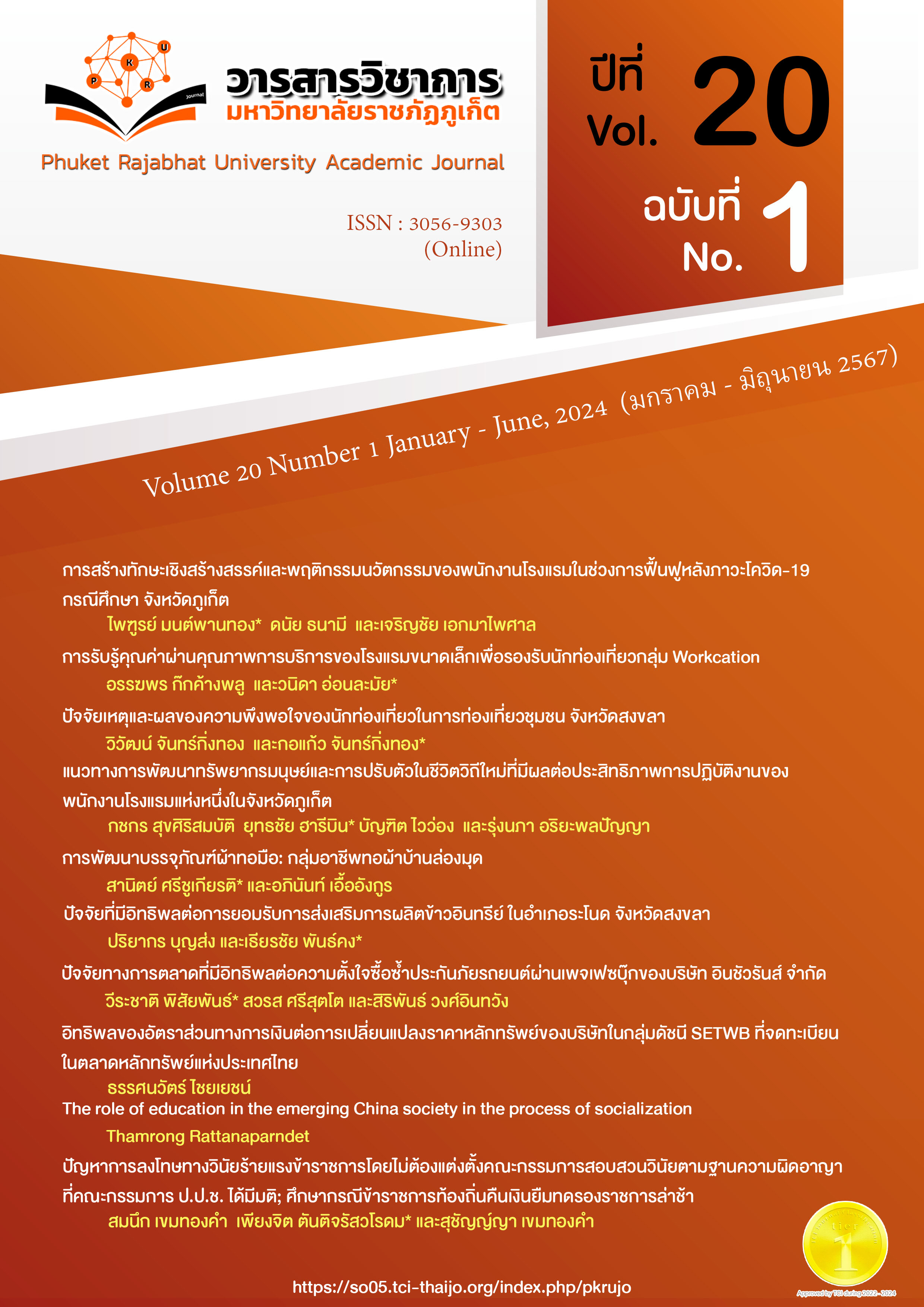การพัฒนากระบวนการสร้างเอกลักษณ์ทางการตลาดสำหรับตลาดท้องถิ่นถนนคนเดินเพื่อการตัดสินใจมาท่องเที่ยว : กรณีศึกษาตลาดท้องถิ่นถนนคนเดิน อำเภอเมือง จังหวัดประจวบคีรีขันธ์
Main Article Content
บทคัดย่อ
การสร้างความเป็นเอกลักษณ์ของลักษณะทางการตลาดการท่องเที่ยวในรูปแบบต่าง ๆ เพื่อให้เกิดการรับรู้อย่างมีประสิทธิภาพต่อการตัดสินใจเที่ยวของผู้บริโภคทางการท่องเที่ยวเป็นเรื่องที่สำคัญ จำเป็น และเป็นปัญหาอย่างหนึ่งของการท่องเที่ยวในแต่ละรูปแบบ ซึ่งรวมถึงการท่องเที่ยวตลาดท้องถิ่นถนนคนเดิน จึงทำให้คณะผู้วิจัยสนใจที่จะศึกษาถึงเอกลักษณ์ของลักษณะการตลาดการท่องเที่ยวเพื่อการตัดสินใจเที่ยวตลาดท้อง ถิ่นถนนคนเดิน มีคำถามการวิจัย คือ เอกลักษณ์ของลักษณะการตลาดการท่องเที่ยวรูปแบบไหนที่เหมาะสมต่อการตัดสินใจเที่ยวตลาดท้องถิ่นถนนคนเดิน? โดยมีการใช้ตลาดท้องถิ่นถนนคนเดิน อำเภอเมือง จังหวัดประจวบคิรีขันธ์ เป็นกรณีศึกษาในครั้งนี้ โดยได้ทำการสัมภาษณ์จากแบบสัมภาษณ์แบบกึ่งโครงสร้าง ควบคู่ไปกับการใช้วิธีรวบรวมจากเอกสารในการเก็บข้อมูลเพิ่มเติมเพื่อให้ครอบคลุมมากยิ่งขึ้นต่อการวิเคราะห์ ซึ่งมีการใช้วิธีการวิเคราะห์เนื้อหา และการวิเคราะห์แก่นสาระ เพื่อให้ได้ผลการวิจัยที่สามารถเป็นแนวทางในการนำไปใช้พัฒนาเอกลักษณ์ของลักษณะการตลาดการท่องเที่ยวเพื่อประโยชน์ในการตัดสินใจมาท่องเที่ยวตลาดท้องถิ่นคนเดิน โดยผลการวิจัย พบว่า การสร้างเอกลักษณ์ของลักษณะการตลาดทางการท่องเที่ยวที่สามารถเจาะลึกลงไปในตัวตนของชุมชนนั้น ๆ หรือ ท้องถิ่นนั้น ๆ ควบคู่ไปกับการวิเคราะห์ข้อมูลผู้บริโภคการท่องเที่ยวตลาดท้องถิ่นถนนคนเดิน และการใช้จิตวิทยาการท่องเที่ยวเพื่อสร้างสรรค์รูปแบบการตลาดท้องถิ่นถนนคนเดินในลักษณะต่าง ๆ ให้เกิดเอกลักษณ์ของตนเองในแบบไม่ซ้ำกันแต่ละช่วงเวลา จะทำให้นักท่องเที่ยวสามารถหวนคิดในการกลับมาท่องเที่ยวซ้ำอย่างสม่ำเสมอ ซึ่งจะช่วยให้เกิดความตื่นตัวทางเศรษฐกิจ การสร้างรายได้ และสร้างอาชีพคืนสู่ท้องถิ่น หรือชุมชนนั้น ๆ อีกทั้งยังช่วยในการอนุรักษ์และเผยแพร่เอกลักษณ์ที่เด่นเฉพาะของแต่ละตลาดท้องถิ่นให้คงอยู่อย่างยั่งยืน
Article Details

อนุญาตภายใต้เงื่อนไข Creative Commons Attribution-NonCommercial-NoDerivatives 4.0 International License.
เนื้อหาและข้อมูลในบทความที่ลงตีพิมพ์ในวารสารวิชาการมหาวิทยาลัยราชภัฏภูเก็ต ถือเป็นข้อคิดเห็นและความรับผิดชอบของผู้เขียนบทความโดยตรง ซึ่งกองบรรณาธิการวารสารฯ ไม่จำเป็นต้องเห็นด้วยหรือร่วมรับผิดชอบใด ๆ
บทความ ข้อมูล เนื้อหา รูปภาพ ฯลฯ ที่ได้รับการตีพิมพ์ในวารสารวิชาการมหาวิทยาลัยราชภัฏภูเก็ต ถือเป็นลิขสิทธิ์ของวารสารวิชาการมหาวิทยาลัยราชภัฏภูเก็ต หากบุคคลหรือหน่วยงานใดต้องการนำทั้งหมดหรือส่วนหนึ่งส่วนใดไปเผยแพร่ต่อหรือเพื่อกระทำการใด ๆ จะต้องได้รับอนุญาตเป็นลายลักษณ์อักษรจากวารสารวิชาการมหาวิทยาลัยราชภัฏภูเก็ตก่อนเท่านั้น
เอกสารอ้างอิง
Alberti, F. G., & Giusti, J. D. (2012). Cultural
heritage, Tourism and regional competitiveness: the Motor Valley cluster. City, Culture and Society, 3(4), 261-273.
Albayrak, T., Caber, M., & Aksoy, S. (2010). Relationships of the Tangible and Intangible Elements of Tourism Products with Overall Customer Satisfaction, International Journal of Trade Economics and Finance, Vol. 1(2), 140-143.
Andriotis, K. (2005). Community groups’ perceptions of and preferences for tourism development: Evidence from Crete. Journal of Hospitality & Tourism Research, 29(1), 67-90.
Beerli, A., & Martin, D. J. (2004). Tourist’s Characteristics and the Perceived Image of Tourist Destinations : A Quantitative Analysis – A Case Study of Lanzarote, Spain, Tourism Management, Vol. 25(5), 623-636.
Chaigassem, T., & Tunming, P. (2019). Identity for cultural tourism of the Bueng Kan Province, Thailand. African Journal of Hospitalty, Tourism and Leisure, 8(1), 1-17.
Cifci, I., Atsiz, O., & Gupta, V. (2021). The Street Food Experience of the Local-Guided Tour in the Meal-Sharing Economy : The Case of Bangkok, British Food Journal, Vol. 123(12), 4030-4048.
Cohen, A. S., Prayag, G., & Moital, M. (2014). Consumer Behaviour in Tourism: Concepts, Influences and Opportunities, Current Issues in Tourism, Vol.17(10), 872-909.
Department of Tourism, Ministry of Tourism & Sports. (2020). Seminars to Upgrade Tourist Attractions to be Safe Tourism Areas (Safety Zone) to Prepare for the Opening of the Country for Tourists. Retrieved June 9 2021.
Mcgehee G. N., & Meares, C. A. (2010). A Case Study of Three Tourism-related Craft Marketing Cooperatives in Appalachia: Contributions to Community, Journal of Sustainable Tourism, Vol. 6(1), 4-25.
McQuilken, L., Breth, R., & Shaw, R. N. (2000). Consumer expectation and satisfaction levels: a evaluation of tourism in the Otawa Region. Proceedings by Bowater School of Management and Marketing, Deakin University.
Foxall, G. (1985). Marketing in the Service Industries, Routledge, London.
Kim, H. J., Chen, M., & Jang, S. (2006). Tourism Expansion and Economic Development: The Case of Taiwan, Tourism Management, Vol. 27, 925-933.
Middleton, V.T.C. (1994) Marketing in Travel and Tourism. Butterworth-Heinemann, Oxford.
Rich, A.-K., & Franch, A.K. (2016). Tourism development in Bagan, Myanmar: perceptions of its influences upon young peoples’ cultural identity. Tourism Planning & Development, 13(3), 333-350.
Sanchez-Sanchez, O.M., De-Pablos-Heredero, C., & Montes-Botella, L. J. (2021). A behavior model for cultural tourism: loyalty to destination. Economic Research-Ekonomska Istrazivanja, 34(1) 2720-2746.
Santos, V., Ramos, P., Sousa, B., Almeida, N., & Valeri, M. (2022). Factors Influencing Touristic Consumer Behavior, Journal of Organizational Change Management, Vol. 35 (3), 409-429.
Sawagvudcharee O., Liu, H., & Zhang C., (2020). Tourist Perceived Value and Quality of Intangible Cultural Heritage souvenirs on Customers’ Purchase Intention: A Case Study of Chinese Tourists, International Journal of Economics, Business and Management Research, 4(7), 181-195.
Song, H., Dwyer, L., Li, G., & Cao, Z. (2012). Tourism Economics Research : A Review and Assessment, Annals of Tourism Research, Vol. 39(3), 1653-1682.
Swarbrooke, J., & Horner, S. (1999). Consumer Behaviour in Tourism, Routledge, London.
Yolles & Fink (2013). Exploring Mindset Agency Theory, Working Paper of the Organisational Coherence and Trajectory (OCT) Project.
Uzzell, D. (1984). An Alternative Structuralist Approach to the Psychology of Tourism Marketing, Annals of Tourism Research, Vol 11, 79-99.
Warasiri K., & Sawagvudcharee O. (2018). The Historical Innovation Ayutthaya Model of Tourism Development. EAU Heritage Journal Social Science and Humanities, 9(3), 245-258.


